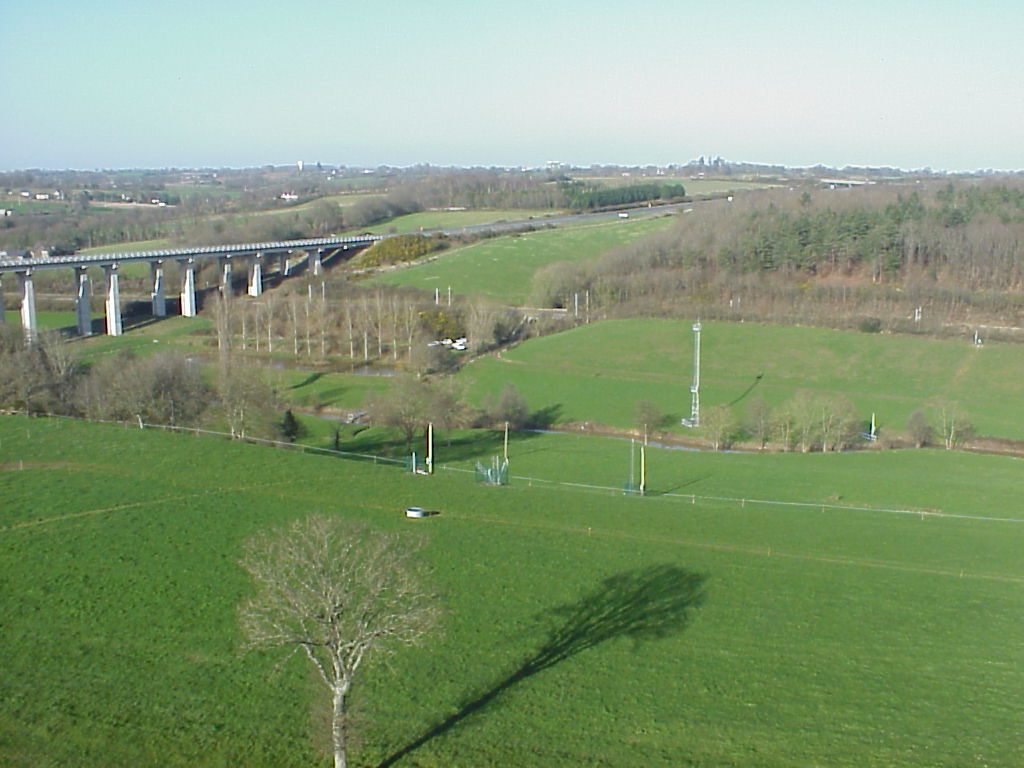![]() In 2001, a noise/meteo monitored site has been settled at Saint-Berthelin (France, 53), leading to an important and unique experimental database which is now freely available to the scientific community in environmental acoustics (see the Terms of use).
In 2001, a noise/meteo monitored site has been settled at Saint-Berthelin (France, 53), leading to an important and unique experimental database which is now freely available to the scientific community in environmental acoustics (see the Terms of use).

general view of the Long Term Monitoring Site (LTMS)
The Long-Term Monitoring Site (LTMS) was set up by LCPC (which has merged with INRETS on January 1, 2011 into Ifsttar) in order to better understand the physical phenomena inherent in the field of environmental acoustics; though noise annoyance can stem from a variety of sources (road and railway traffic, airplanes, industrial noise, etc.), they all display similar characteristics with respect to the physical phenomena involved in long-range sound propagation. This research topic still encounters some major scientific obstacles despite the interest shown by the international scientific community and despite the resources allocated in this research domain over the past decades. At the same time, regulatory and standards organizations are severely constrained due to public pressure: the number of people exposed to noise-related nuisances from roads, railways and industries being continuously on the rise; this has spurred the need to improve the reliability of numerical and experimental tools for estimating sound levels (and other indicators) in the environment.
Measured and/or modelled sound levels depend on a wide array of physical phenomena: diffraction, diffusion, reflection, etc. In particular, the combined influence of micrometeorological effects and ground effects leads to great sound dispersion as the distance to a sound source increases. Such effects differ over highly-variable space and time scales, and their relative influence on the acoustic field depends significantly on both the geometric configuration and propagation conditions: average vertical wind and temperature profiles, atmospheric turbulence characteristics, ground impedance properties, etc.
The benefit of setting up such a continuous monitoring site for a long observation period (at least 10 years) lies in quantifying the influence of micrometeorological conditions on acoustic field variability at the local scale (i.e. site scale), in contrast with the regional scale (i.e. Météo-France weather stations). These research efforts focus on spatial aspects (site effects) as well as temporal aspects (short vs. long term), in the aim of deriving an estimation of space-time variability of critical sound pressure levels (SPL) on any site over short-, medium- and long-term periods.
This LCPC-backed Development Project was initiated in 1999 and has been running since 2001, with a planned period of operations covering at least 10 years. Its activities now fall within the scope of Ifsttar Research Project 11R106 Noise predictions in inhomogeneous media: From territory scale to street scale (2010-2013). Some hardware and software improvements have been carried out during 2008. The considering period in the present validated database is 2002-2007 (see the User guide included in the archive for more details).
Thus LTMS consists in a permanent acquisition (monitoring) over at least 10 years (sampling interval: 10 sec) of sound pressure levels (global A Leq, 1/1 octave, etc.) and micrometeorological characteristics (wind speed and direction, air and ground temperature, rainfall, solar insolation, etc.) at several points on the site via: five 5m high acoustic masts (with 2 sensor heights), two 25m high meteorological towers (3 sensor heights), and two 10m high meteorological towers (2 sensor heights). In conjunction with this equipment, an onsite traffic counting station is operational 24 hours a day 365 days a year. Ground characteristics measurements are also performed regularly (once a month) at 12 points on the site (optimised spatial sampling) to yield the sound energy absorbed by the ground (acoustic impedance).
The daily database set generated (approx. 10 megabytes/day) is then preprocessed, synchronised, concatenated packed and then transferred to a Web host site (with an FTP protocol). Before each use, these data first undergo detailed validation post-processing (using filters) in order to detect sensor malfunctions, parasitic noise events, etc. The various tasks required for system hardware and software maintenance, preventive and remedial monitoring, acquisition, data preprocessing and post-processing are allocated considerable human and technical resources by the Scientific and Technical Network (STN) of the national ministry, with contributions coming mainly from LCPC, CETE-Western Office and CETE-Normandy-Centre Office (see the User guide included in the archive for more details). Experimental data are then analysed in collaboration with Ifsttar-affiliated research institutes/laboratories, e.g. EDF R&D, SNCF, INRA, ECL, ECN, CSTB, ENSMP, Météo-France, etc.
See the Terms of use
